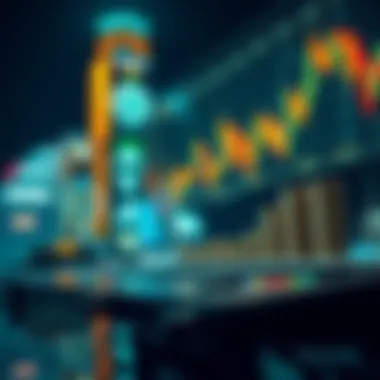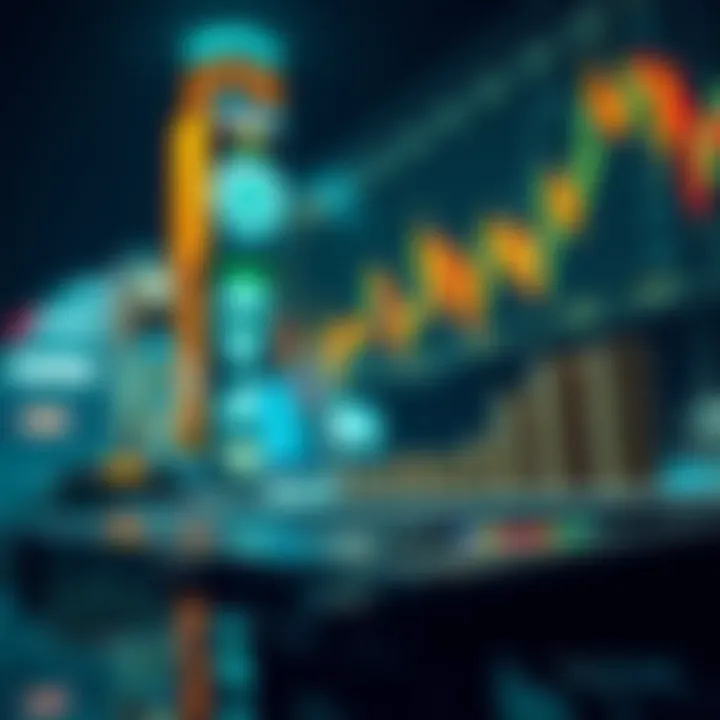Best Practices for Successful Foreign Exchange Trading


Intro
Navigating the landscape of foreign exchange trading requires more than just a passing familiarity with currency pairs. Young professionals, students, and small business owners alike can benefit from understanding the intricate details of this financial sector. The foreign exchange market can be a bit like learning a new language—lots of terms and subtle nuances that can make a world of difference.
Understanding Budgeting
In finance, budgeting is not merely an arithmetic exercise; it’s about setting yourself up for success in** forex trading**. If you want to thrive in the currency exchange environment, grasping the principles of budgeting is crucial. It’s like drawing a roadmap before embarking on a journey, helping you identify potential pitfalls and maximizing your resources.
Importance of Budgeting
Every trader should appreciate the significance of a solid budget plan. By creating a budget specific to forex, you can determine how much capital you can afford to commit. Remember, you wouldn’t dive into a swimming pool without checking the water’s depth first, would you? In many ways, your budget helps you gauge your risk tolerance and set realistic expectations.
Creating a Budget Plan
Here’s the rub—creating a budget plan for forex trading requires more than just jotting down numbers. It involves a thorough analysis of your income, expenses, and trading ambitions. You’ll want to factor in not just your trading capital, but also other life expenses like rent, bills, and even your morning coffee.
To begin:
- Assess your financial situation: Look at your earnings and outflows.
- Determine trading funds: What can you allocate to your trading activities without putting your essential expenses at risk?
- Set limits: Establish boundaries that prevent you from emotional trading or exceeding your budget.
Tracking Expenses
After setting up your budget plan, the next step is to keep a close eye on your expenses. It’s a common mistake to ignore small purchases that add up over time. In forex, every bit counts, and so does tracking your expenditures on trading tools, subscriptions, or analyses that you might overlook.
Some ways to keep track include:
- Journaling your trades: Note the performance of your trades alongside the costs incurred.
- Using spreadsheets: This old-school method still works wonders for clarity and accuracy.
- Investing in budgeting apps: Tools like Mint or YNAB (You Need A Budget) can make it simpler to visualize your financial health.
Budgeting Tools and Apps
Investing in the right tools can work wonders for your budgeting journey. Here’s a quick rundown:
- Mint: It helps in all-around expense tracking.
- YNAB: A real-time budgeting tool that educates you as you use it.
- Excel Spreadsheets: Sometimes, the classic approach fits best—fully customizable and no subscription fees!
In summary, mastering your budget is foundational to sustaining a healthy trading practice in the foreign exchange market. Establish your financial parameters, utilize technology to track your progress, and arm yourself with the knowledge to approach forex with confidence.
Understanding Foreign Exchange
Understanding foreign exchange is not just about trading currencies; it's about grasping the intricate financial web that connects economies worldwide. Forex, as it's commonly called, is pivotal for international trade, investments, and the overall health of global economies. When you dive into the nuances of forex, you’ll uncover the mechanics that drive currency valuation, the geopolitical undercurrents influencing market movements, and the methods traders use to optimize their strategies.
For young professionals, students, and small business owners, understanding this market enhances not only financial literacy but also aids in making informed decisions when engaging in cross-border activities. Left unchecked, the complexities of forex can lead to miscalculations or lost opportunities. On the flip side, it opens doors to potential profits if approached strategically.
Definition and Scope
The foreign exchange market is essentially where one currency is traded for another. Consider it a global marketplace that operates 24/5 — five days a week, without a centralized location or governing body. It encompasses major currencies such as the U.S. Dollar, Euro, and Japanese Yen, along with lesser-known currencies. The scope of foreign exchange is vast, ranging from transactions between individual traders to multinational corporations hedging against currency fluctuations.
To put things in perspective, think of the sheer volume of transactions: trillions of dollars change hands daily, making it one of the largest financial markets globally. Understanding the terminology used, like pips, spread, and leverage, forms the bedrock of forex proficiency.
Historical Context of Forex Trading
Forex trading has roots that stretch back centuries. In ancient times, trade exchanges were conducted on a barter system, which obviously had its limitations. It wasn’t until the emergence of gold and silver coins that standardized currency began to emerge. Fast forward to the 20th century, and we encounter the Bretton Woods Agreement, a significant turning point. This accord established fixed exchange rates pegged to the U.S. Dollar, which in turn was backed by gold.
However, the system collapsed in 1971, leading to the free-floating exchange rates we see today. This shift was not merely a financial evolution but also reflected the changing dynamics of global trade, leading to an era where currencies can fluctuate based on market demand, interest rates, and political stability.
As forex trading matured, it became accessible to retail traders in the late 1990s due to technological advancements and online platforms. This democratization transformed who could participate, paving the way for individuals and small businesses to engage in the market.
Understanding this historical context helps traders appreciate the current market landscape, making them better equipped to navigate the intricate realities of forex trading today.
The Mechanics of Forex Trading
Understanding the mechanics of forex trading is crucial for anyone looking to navigate the complexities of the foreign exchange market. This section delves into the core elements that shape trading decisions, including the foundation of currency pairs, bid and ask prices, and their implications for traders. Being familiar with these mechanics not only empowers traders to make informed decisions but also helps in optimizing returns while mitigating risks.
Currency Pairs Explained
The fundamental building blocks of forex trading hinge on currency pairs. Each pair reflects the value of one currency against another, and this dynamic is where traders identify potential profit opportunities. The three categories of currency pairs—Major, Minor, and Exotic—serve different kinds of traders based on their styles and objectives.
Major Pairs
Major pairs are the most widely traded currencies in the world, including combinations like EUR/USD, USD/JPY, and GBP/USD. The key characteristic of these pairs is their high liquidity; they tend to have tighter spreads and less volatility compared to others. Such traits make them a popular choice for both novice and experienced traders alike.
The unique feature of major pairs is their sensitivity to significant global economic events. For instance, economic indicators such as GDP reports and employment figures can deeply impact prices. While major pairs offer lower risk levels due to their established nature, traders must still stay vigilant, as geopolitical events can strain currencies unexpectedly.
Minor Pairs
Minor pairs consist of currencies that are less frequently traded, such as AUD/NZD or GBP/CHF. The main aspect that sets them apart from major pairs is their relative lack of liquidity and larger spreads. This can deter some traders, but minor pairs offer unique trading opportunities, especially when traders develop specialized knowledge about specific currency economies.
The key advantage of trading minor pairs is that they may react differently to global events compared to major pairs. For example, a shift in market sentiment may lead to more pronounced price movements within these pairs. However, traders should note that their less predictable nature can also introduce a new layer of risk. Understanding the specific catalysts that influence these pairs is essential for success.
Exotic Pairs
Exotic pairs involve a major currency paired with one from a developing or emerging economy, like USD/TRY (Turkish Lira) or USD/ZAR (South African Rand). The chief characteristic of exotic pairs is increased volatility paired with liquidity concerns. While they might attract adventurous traders looking for opportunities with higher potential returns, they come with their own drawbacks.


What makes exotic pairs intriguing is their ability to react sharply to political and economic changes. For instance, a political upheaval in a developing nation could cause significant fluctuations in its currency. On the downside, wider spreads and slippage can affect trading outcomes adversely, making risk management even more critical.
Bid and Ask Prices
In forex trading, understanding bid and ask prices is indispensable. The bid price represents the maximum price a buyer is willing to pay for a currency pair, while the ask price is the minimum price a seller will accept. The difference between these two is known as the spread, which can vary considerably based on market conditions. Traders must recognize that, effectively, they buy at the ask price and sell at the bid price.
"In forex, understanding spreads can define your success. Pay close attention to them."
Accurate knowledge of these prices enables traders to gauge trade costs and determine break-even points more effectively. For example, in a highly liquid market for a major pair like EUR/USD, you might find spreads as low as 1 pip, making trading more cost-effective. In contrast, trading less liquid pairs can lead to spreads widening, impacting overall profitability.
By mastering these mechanics, traders can position themselves strategically within the forex market, optimizing their approach to achieve success.
Essential Trading Strategies
In the world of foreign exchange, effective trading strategies can mean the difference between profit and loss. Essential trading strategies form the backbone of a successful trading approach. They help traders navigate the volatile financial waters, minimize risks, and maximize their potential returns. Understanding and employing these strategies is crucial for anyone looking to succeed in the forex markets. Think of it as having a roadmap through a maze; without it, you might find yourself lost.
Technical Analysis in Forex
Charting Techniques
Charting techniques are a critical element of technical analysis, and they certainly earn their place among the best practices of forex trading. Essentially, they allow traders to visualize past price movements and forecast potential trends. This provides valuable insights that can guide trading decisions. Traders often utilize various types of charts, such as line charts, candlestick charts, and bar charts, each with distinct characteristics.
The most popular choice among traders is the candlestick chart. It shows the opening, closing, high, and low prices over a specified period, offering a clearer picture of market sentiment. One unique feature of this charting technique is its ability to highlight market reversals through specific formations, like the engulfing or hammer candlesticks. The advantage here is the ability to identify entry and exit points more efficiently. However, it's essential to be cautious; interpreting candlestick patterns requires practice, and misreading them can lead to significant losses.
Indicators and Tools
Indicators and tools are commonly used in technical analysis to supplement charting techniques. They assist traders in making informed decisions based on mathematical calculations derived from price data. Some of the most popular indicators include Moving Averages, Relative Strength Index (RSI), and Bollinger Bands, each offering different insights into market dynamics.
The Moving Average indicator, for instance, smooths out price data to identify trends over a specific period. This can help determine whether a currency is in an upward or downward trend. A unique aspect of this tool is the decision-making it facilitates; traders can identify points at which to enter or exit positions based on crossovers. However, relying solely on one indicator is not advisable, as each has its limitations and contexts where they shine or falter.
Fundamental Analysis
Economic Indicators
Economic indicators play a pivotal role in forex trading, reflecting the health of a country's economy through various data points. Understanding these indicators helps traders grasp fundamental forces affecting currency values. Common economic indicators include Gross Domestic Product (GDP), unemployment rates, and inflation metrics like Consumer Price Index (CPI).
One key characteristic of economic indicators is their scheduled release dates, which can often lead to increased volatility. For instance, when the U.S. Bureau of Economic Analysis releases GDP data, traders may react instantly, causing significant price swings. Recognizing how these indicators correlate with market expectations can provide a competitive edge, but it's essential to note the potential for misinformation or misleading interpretations, which can lead to poor decisions.
News Impact
The impact of news cannot be overstated in the forex market. Global events influence trader sentiment and market movements significantly. Economic reports, political unrest, or major announcements like interest rate changes can lead to rapid shifts in currency prices. One of the defining aspects here is the unpredictability of news—while some news is expected and priced in advance, surprises can result in sudden and unpredictable market reactions.
Traders often utilize a forex news calendar to track upcoming events and prepare accordingly. This tool highlights significant events that may impact currency movements. While capitalizing on this information can be profitable, news trading carries risks; misjudging market reactions based on anticipated outcomes can lead to losses. Thus, combining news analysis with technical indicators often leads to a more balanced trading strategy.
In summary, mastering both technical and fundamental analysis is a fundamental part of developing effective trading strategies. Each approach offers distinct yet complementary insights that can enhance a trader's overall understanding of the forex market.
Risk Management Techniques
In the volatile world of forex trading, understanding risk management techniques is critical for anyone looking to not just survive but thrive. These techniques help traders mitigate losses and protect their capital while still allowing for profitability. At its core, effective risk management is about making informed decisions that balance potential risk with potential reward. A solid grasp of these practices not only enhances trader confidence but also lays the foundation for a sustainable trading career.
Key elements of risk management include having a clear plan, knowing your risk tolerance, and utilizing tools that can help safeguard your investments. Each element serves a distinct purpose, collectively ensuring that traders make smarter choices and avoid common pitfalls. Without a robust risk management strategy, even the most skilled traders can find themselves financially drained after just a few bad decisions.
As a trader, you must be aware that overexposure can lead to substantial losses. Incorporating risk management means you have a plan in place for when things go south. Acknowledging that losing trades are an inevitable part of the trading life is crucial. Accepting this fact is the first step toward developing a solid trading mindset. Here are some key components to consider when managing your trading risks:
- Consistent Strategy: Keep the trading plan consistent and adapt only when the market proves a change is necessary.
- Risk-Reward Ratio: Understand the ratio of potential profits to losses for each trade you make.
- Use of Analytics: Regularly assess trading performance to identify successful strategies versus those needing adjustment.
Setting Stop-Loss Orders
One of the paramount methods in risk management is the establishment of stop-loss orders. A stop-loss order is a predetermined price that triggers an automatic sale of your currency when the market moves against you. This approach protects your account from significant losses, ensuring you only lose what you are willing to risk on any given trade.
Benefits of Stop-Loss Orders
- Prevention of Emotionally Driven Decisions: When markets are volatile, fear can cloud judgment. A stop-loss order can alleviate this by executing a sale without emotional interference.
- Capital Preservation: Protecting your trading capital is essential. Even a small loss can lead to bigger consequences if it becomes a pattern. Stop-loss orders serve as a safety net that keeps your capital intact.
- Automation: By setting a stop-loss in advance, you can focus on more critical trading decisions without constantly monitoring the market.
It's worth noting that setting a stop-loss isn’t about eliminating risk altogether; it’s about managing it effectively. A well-placed stop-loss can save you from unanticipated downturns while still allowing your more favorable trades to run.
"In forex trading, the best defense isn’t just a good offense. It’s about managing risks ahead of time."
Position Sizing Strategies
Position sizing strategies are another cornerstone of effective risk management. Position sizing refers to the amount of currency you choose to buy or sell in a single trade based on your total account size and risk tolerance. This determination can significantly affect your overall trading results.
Factors Influencing Position Sizing
- Account Size: A trader's overall capital will dictate how much can be risked on each trade. Smaller accounts may mean smaller positions to minimize risk.
- Risk Tolerance: Each trader should assess how much of their capital they are comfortable risking on a single trade. Setting this threshold is crucial in determining position size.
- Market Conditions: Different market conditions can affect volatility, and therefore, the amount of risk you associate with a trade should adjust accordingly.
Effective Position Sizing Techniques
- Percentage of Account: Some traders opt to risk a fixed percentage of their account on each trade. This limits risk while allowing for the potential of growth.
- Fixed Dollar Amount: Other traders may choose to set a specific dollar amount they are willing to risk per trade. This approach can be easier to implement and maintain.
In essence, position sizing is about aligning your trades with your overall trading philosophy and lifestyle.
Resources for further reading on risk management can be found at: Investopedia and Babypips.


Understanding and applying these risk management techniques are vital for becoming a seasoned forex trader. As the marketplace shifts and evolves, so too should your strategies. Mastery in stopping losses and clever position sizing equips traders to navigate the intricate world of forex with greater confidence.
Selecting Trading Platforms
In the world of foreign exchange, choosing the right trading platform is akin to picking the correct tools for a master craftsman. A good platform can elucidate complex market dynamics, while a poor one can hinder performance and lead to astronomical losses. For traders, both novice and seasoned, understanding what to look for in a platform can significantly influence their trading success. The right platform not only streamlines trading activities but also provides the necessary resources to make informed decisions, ultimately affecting profitability.
Features to Consider
User Interface
When discussing the user interface (UI) of a trading platform, it’s vital to appreciate its impact on user experience. A clean, intuitive interface can make the difference between confident trades and cumbersome frustrations. Traders need platforms that exhibit clarity with their functionalities to allow seamless navigation, which is especially crucial during volatile market conditions.
One key characteristic of an effective user interface is its customization options. Traders often appreciate being able to tailor their workspace to suit their preferences, be it through chart layouts or tool accessibility. This personalization not only enhances comfort but also improves efficiency.
A unique feature that many platforms offer in their UI is the ability to incorporate real-time analytics. This functionality allows traders to act fast on the latest information. However, it’s important to note that a feature-heavy interface may lead to information overload for less experienced users, causing confusion when trying to discern critical data. Therefore, striking a balance between functionality and simplicity is paramount.
Transaction Costs
Transaction costs can significantly shape a trader's bottom line. These costs encompass all the fees associated with executing trades, which includes spread, commission, and other charges imposed by the broker. An attractive aspect of low transaction costs is that they allow traders to retain more of their profits, making them a vital consideration while choosing a trading platform.
A primary characteristic of transaction costs is their variability; they can change based on factors like account type and trading volume. This variability makes it essential for traders to assess their own trading styles before committing to a platform.
Platforms often advertise low transaction costs to entice users. However, traders should be wary of hidden fees that might sneak into the picture. When considering transaction costs, transparency is key. An ideal platform would clearly outline all potential charges to avoid any surprises down the line.
Regulatory Considerations
Selecting a trading platform doesn’t just stop at evaluating features and costs; regulatory considerations are equally important. A platform should be licensed and regulated by a reputable authority, as this ensures a level of security and compliance with legal standards. Regulators like the Financial Conduct Authority in the UK or the Commodity Futures Trading Commission in the US work to protect traders from malpractice and fraud.
Traders should seek platforms that display their regulatory status prominently. A good sign is membership in investor compensation schemes, as it offers a safety net should the broker face insolvency. When evaluating a platform, researching its past compliance history can uncover red flags.
Economic Factors Influencing Forex
Understanding the economic factors that affect foreign exchange is crucial for traders at every level. While many elements influence currency valuations, two stand out significantly: interest rates and political stability. They shape market expectations, affect economic performance, and ultimately dictate currency strength.
With tight interconnections among global economies, it's essential for young professionals, students, and small business owners to grasp these economic factors fully. They not only provide insights into the current market conditions but also help traders anticipate future moves based on economic forecasts.
Interest Rates and Their Effects
Interest rates are like the pulse of an economy, determining borrowing costs and influencing spending. When central banks adjust interest rates, they send ripples throughout the forex market.
For instance, if the Federal Reserve raises interest rates in the United States, it could bolster the value of the U.S. Dollar. This happens because higher interest rates offer better returns on investments denominated in that currency, attracting foreign capital.
Here are some key points on how interest rates affect forex:
- Capital Flows: Higher interest rates generally attract foreign investments, leading to increased demand for the higher yielding currency.
- Inflation Control: Central banks use interest rate adjustments to control inflation, which can directly affect forex prices. If inflation is kept in check via higher rates, it can positively impact currency strength.
- Comparison Across Economies: Traders often compare interest rates across countries, leading to strategic trades based on these comparisons.
Suddenly, a shift in just one country’s rate can trigger drastic changes in currency pairings. To stay ahead, traders must maintain an acute awareness of central bank policies and forecasts.
"In forex, even a small change in interest rate can sway the tides in the currency markets."
Political Stability and Economic Impact
The political climate of a country plays a significant role in its currency valuation. When political stability is present, investors generally feel confident investing in that nation, leading to currency appreciation. Conversely, political turmoil can result in depreciation.
For example, during times of election uncertainty, traders often watch the situation closely. If one candidate seems likely to implement pro-business policies, the local currency might experience a bump. On the flip side, uncertainty can lead to a flight to safety, often increasing demand for stable currencies like the Swiss Franc.
Consider this when assessing political conditions:
- Policy Changes: An incoming administration may lead to significant policy shifts affecting economic performance, hence currency stability.
- Geopolitical Events: Wars, protests, and international relations all have the potential to shake investor confidence and influence currency demand.
- Economic Partnership: Countries with strong, stable governments can foster better trade deals, which improves economic health and, in turn, currency strength.
Understanding these economic factors is not just for experienced traders. Young professionals or students venturing into forex markets must appreciate how intertwined politics and economics are to make informed trades.
As global markets evolve, these influences will continue to shift, prompting curious traders to stay one step ahead. By keeping tabs on interest rates alongside political stability, valuable insights can emerge, offering a competitive edge in the challenging forex landscape.
Common Mistakes to Avoid
Navigating the world of foreign exchange trading can feel like walking a tightrope, with many risks lurking under the surface. Recognizing and steering clear of common pitfalls is essential for both newcomers and seasoned traders alike. Understanding these mistakes can not only safeguard capital but also enhance overall trading performance. Below, we will delve into two significant errors that traders often make: overleveraging and neglecting market research.
Overleveraging
Overleveraging is a trap many traders fall into, thinking it will exponentially increase their profits. But the reality is much harsher. When a trader uses excessive leverage, they’re amplifying both their potential gains and losses. For instance, if a trader bets $100 on a leverage factor of 50:1, their exposure in the market is effectively $5,000. While the allure of such profits can be intoxicating, it only takes a slight market swing to wipe out an investment.
It’s crucial to approach leverage with caution. Always remember that leverage is a double-edged sword. Here are certain points worth noting on the subject:
- Know Your Limits: Decide beforehand how much you’re willing to risk for each trade without breaking the bank.
- Use a Safe Leverage Ratio: Many seasoned traders recommend a leverage ratio of 10:1 or lower for beginners.
- Diversify Investments: Don’t put all your eggs in one basket, as it mitigates risk exposure.
In summary, while the ability to control large amounts of money can be enticing, proper management of leverage remains crucial. Always weigh the advantages against potential drawbacks and consider a more conservative approach, particularly when starting.
Neglecting Market Research
In the fast-paced realm of forex trading, there’s a tendency for traders, especially newcomers, to leap into trading based purely on gut instincts or tips from friends. This is akin to jumping into a pool without checking how deep the water is. Conducting thorough market research lays the groundwork for informed decision-making. Ignoring this can lead to mistakes that could've been avoided with just a bit of homework.
Market research involves analyzing economic indicators, regional news, trading trends, and historical data. At the heart of successful trading lies a comprehensive understanding of both macroeconomic and microeconomic factors. Here’s what you should consider:
- Stay Updated on Economic Indicators: Factors like employment rates, inflation, and GDP can significantly influence currency movements.
- Follow Geopolitical Events: Political stability, elections, or international policies can shift market perceptions and currency values.
- Utilize Trading Tools: Various platforms and tools are available to assist traders in gathering relevant market information—take advantage of them.


"Knowledge is power; it is the engine that drives decision-making in trading. A well-informed trader is a step ahead of the game."
The Role of Technology in Forex
In recent years, technology has reshaped numerous sectors, and foreign exchange trading is no exception. The importance of technology in forex can’t be overstated; it influences the way traders engage with the market, manage risk, and execute their strategies. As trading platforms integrate more innovative features, the barriers to entry lower, attracting a surge of new traders. This evolution not only enhances user experience but also promotes greater efficiency in the market.
Algorithmic Trading
Algorithmic trading refers to the process of using computer algorithms to execute trades. This method has become essential in forex due to its ability to handle large volumes of data and execute trades in fractions of a second. Traders no longer need to rely solely on intuition; algorithms can analyze market trends, historical data, and price fluctuations to make informed trading decisions.
Moreover, algorithmic trading minimizes human error, a crucial factor in the high-stakes world of forex. Imagine a trader manually inputting buy and sell orders in a fast-moving market. It's akin to trying to catch a greased pig - tricky and, at times, downright slippery. On the other hand, well-designed algorithms can operate continuously, seizing opportunities that a human might miss.
Benefits include:
- Speed: Algorithms can instantly analyze data and execute orders faster than any human.
- Consistency: Trading decisions are based on predefined criteria and logic, reducing emotional bias.
- Backtesting: Traders can test their strategies against historical data to identify potential weaknesses and strengths before going live.
"Algorithmic trading can unlock untapped potential, offering traders insights into market movements that were once hidden."
It's worth noting that algorithmic trading is not without its challenges. Traders must ensure they set parameters correctly; otherwise, they risk significant losses. Additionally, reliance on technology means traders must stay informed about software updates and changes in trading platforms.
Mobile Trading Applications
The rise of mobile trading applications has made forex trading more accessible. Gone are the days when having to be tethered to a desk in front of a computer was a requirement. These apps allow traders to monitor their accounts and execute trades from virtually anywhere, whether it’s a café, a park, or even during their commute.
Mobile applications come packed with features like real-time market data updates, charting tools, and even social trading aspects, allowing users to follow and imitate the strategies of seasoned traders. This is particularly appealing to young professionals and students, as the flexibility they offer fits into busy lifestyles. Mobile apps bridge the gap between traditional trading methods and modern convenience, making it possible for users to be in tune with market movements at all times.
Considerations for using mobile trading applications:
- Security: Users should prioritize platforms that offer robust security measures to protect sensitive data.
- Usability: An intuitive interface can enhance the trading experience by making navigation smoother and more efficient.
- Connectivity: Trading relies heavily on stable internet connections; thus, having a reliable mobile network is crucial.
Future Trends in Forex Trading
As the world of commerce continues to evolve at a dizzying pace, staying ahead of the curve in foreign exchange trading is more crucial than ever. The forex market is not just about buying and selling currencies based on their perceived value anymore; it's about understanding the dynamics of a globally connected economy. Emerging trends shape trading strategies and offer fresh opportunities for investors who are willing to adapt. By keeping an eye on these trends, traders can position themselves effectively for both short-term gains and long-term sustainability.
The future of forex trading hinges on two primary elements: the rise of cryptocurrencies and the extensive effect of globalization. Each of these factors presents distinct benefits and considerations for traders navigating this complex landscape.
Emergence of Cryptocurrencies
The rise of cryptocurrencies, such as Bitcoin and Ethereum, has dramatically altered the forex trading environment. These digital currencies are no longer just speculative assets; they have matured into viable options for investors. Trading with cryptocurrencies introduces a fresh layer of volatility and opportunity, but not without its own set of challenges.
Despite their fluctuating nature, cryptocurrencies feature several compelling advantages:
- Decentralization: Unlike traditional currencies, cryptocurrencies function on a peer-to-peer basis without a central authority. This characteristic can offer greater transparency and reduce the risk of manipulative practices often found in fiat currencies.
- Accessibility: Cryptocurrencies can be traded anytime, anywhere, presenting a significant edge for traders who prefer to engage in off-hour transactions.
- Low Transaction Costs: Many cryptocurrency platforms boast minimal fees compared to conventional forex exchanges, making them appealing to those looking to maximize profitability.
However, as promising as they may appear, cryptocurrencies also come with their own set of risks:
- Regulatory Uncertainty: Governments worldwide are still grappling with how to regulate digital currencies. Changes in regulations can have immediate and profound effects on their market value.
- High Volatility: While volatility can create trading opportunities, it also increases risk. Traders must have a robust risk management strategy in place when dealing with cryptocurrencies.
Finding a balance between the potential for gains and managing the risks involved with cryptocurrencies will be key for savvy forex traders moving forward.
Impact of Globalization
In an interconnected world, the implications of globalization loom large over forex trading practices. It affects everything, from supply chains to currency valuation, reshaping how traders assess market dynamics.
Globalization brings forth several essential considerations:
- Instant Information Flow: News travels faster than a bumblebee can buzz. Forex traders must keep up with global financial news, economic reports, and geopolitical events, as any of these can sway currency values in a minute.
- Increased Competition: Forex trading has become accessible to a broader audience, leading to increased competition in the marketplace. This necessitates that traders maintain high standards in their strategies and analyses.
- Diversification Opportunities: Globalization allows traders to tap into various markets effectively. A trader based in Europe can easily engage with Japanese yen or Australian dollar, optimizing their portfolio through strategic investments across different regions.
"The heart of globalization beats in forex—if you fail to adapt, you might find yourself left in the dust."
With the landscape constantly shifting, understanding these criteria can set aspiring traders apart. Staying informed and agile to these changing trends is paramount for success in the foreign exchange market.
Keeping an eye on emerging trends in cryptocurrencies and the broader impact of globalization could lead to actionable strategies that enhance overall performance in forex trading.
Ending
The topic of concluding insights in the realm of foreign exchange trading acts as a critical juncture for both budding traders and seasoned professionals. This article has navigated the vast landscape of foreign exchange, shedding light on the multitude of practices that can enhance trading success. As we wrap up, it’s imperative to emphasize several essential elements that underpin effective trading strategies.
In reviewing the key teachings from previous sections, one can gather a comprehensive outlook on the balancing act between risk management and opportunity recognition. For instance, the discussions on risk management techniques, such as setting proper stop-loss orders and understanding position sizing, cannot be overstated. These strategies aid traders in mitigating potential losses while optimizing their chances for gains. Moreover, the insights into critical economic factors including interest rates and political stability serve as a barometer for effective trading decisions.
"A well-informed trader is akin to a seasoned captain navigating through turbulent seas."
Understanding the volatility of currency pairs and the influences that drive market fluctuations is not just academic; it directly impacts decision-making and financial outcomes. Furthermore, as advancements in technology reshape the trading landscape, embracing tools like algorithmic trading and mobile applications adds a layer of efficiency that is indispensable in today’s fast-paced environment.
To encapsulate the importance of mastering these practices, aspiring forex traders must recognize that it is not solely about acquiring knowledge; it is also about applying that knowledge with discipline and foresight. Having a structured approach, grounded in the principles discussed throughout this article, empowers traders to forge their paths in the vast world of foreign exchange.
Summarizing Key Learnings
Taking stock of what has been covered provides clarity and reinforces the knowledge necessary for trading success. Here are several takeaways:
- Understanding Forex Fundamentals: The foundation of currency trading lies in a firm grasp of forex terminology, mechanisms, and market structure. The intricacies of currency pairs, ranging from major, minor to exotic pairs, highlight the diverse options traders can utilize.
- Robust Trading Strategies: Employing thorough technical and fundamental analyses are critical components in developing successful trading strategies. This includes utilizing various indicators and staying updated on global economic news.
- Implementing Risk Management: Strategies like stop-loss orders and appropriate position sizing safeguard against unforeseen market movements, ensuring that traders remain resilient in fluctuating conditions.
- Leveraging Technology: The integration of algorithmic trading and adaptable trading platforms has transformed how trading is conducted, providing traders with tools for enhanced performance.
Future Steps for Aspiring Traders
For those looking to carve a niche in forex trading, implementing the following future steps can facilitate ongoing growth and development:
- Continuous Education: The forex market is continuously evolving. Engaging with online courses or webinars, following thought leaders on platforms such as Reddit and Facebook, and staying attuned to updates on financial news can sharpen one’s trading acumen.
- Develop a Trading Plan: A well-structured trading plan outlines every aspect of a trader’s activities, from goals and strategies to risk management. This acts as a roadmap for sustained performance in the market.
- Practice with Demo Accounts: Many trading platforms, such as MetaTrader 4 and 5 or ThinkorSwim, offer demo accounts. These allow traders to practice strategies without risking real capital.
- Network with Other Traders: Engaging in forums and discussions with fellow traders can provide advice and insights that are invaluable. Communities on sites like Reddit often share tips and strategies that can enhance the learning experience.
By taking these steps, aspiring traders not only build a robust foundation for their trading careers but also join a community of informed practitioners looking to master the art of foreign exchange. Remember, in this field, the only constant is change, and adaptability will define the level of success one achieves.



